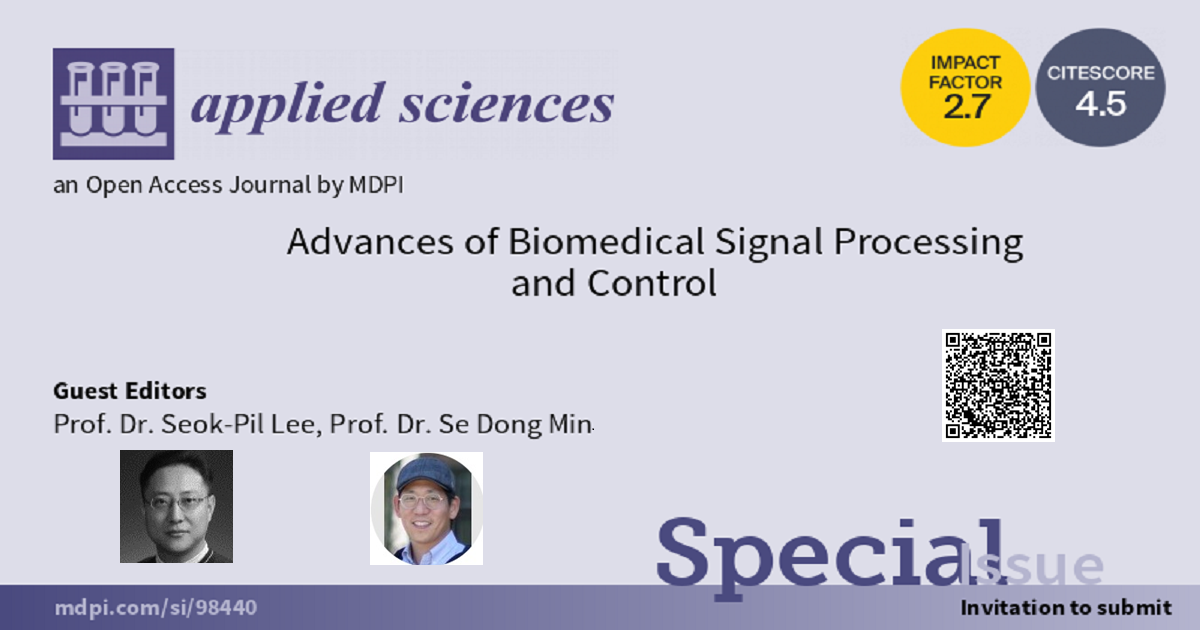Advances of Biomedical Signal Processing and Control
A special issue of Applied Sciences (ISSN 2076-3417). This special issue belongs to the section "Applied Biosciences and Bioengineering".
Deadline for manuscript submissions: closed (31 July 2023) | Viewed by 23514

Special Issue Editors
Interests: gesture recognition; flexible epidermal tactile sensor array; wearable device; wearable sensor gesture recognition; tactile sensors; Internet; biomechanics; collaborative filtering; computational complexity; data encapsulation; discrete cosine transforms; electroencephalography; electromyography; emotion recognition; extra features
Interests: biomedical signal processing; mobile healthcare; wearable healthcare; smart health; digital therapeutics
Special Issues, Collections and Topics in MDPI journals
Special Issue Information
Dear Colleagues,
Over the past forty years, technology has evolved impressively and led to unimaginable advances in computing power and memory capacity, with significant reductions in size and cost. Despite this technological progress, however, biomedical signal processing and control (theory, methods, and their applications) has only made small steps, while in other fields, such as speech recognition and synthesis, signal processing improvement has been remarkable with an extraordinary spread of applications.
Biomedical signal processing and control have enabled a dynamic area of expertise in both academic and research aspects of biomedical engineering. Biomedical signals include electrocardiogram (ECG), electromyogram (EMG), electroencephalogram (EEG), photoplethysmogram (PPG), coughing sound, blood pressure (BP), etc.
In particular, this Special Issue is concerned with signal processing, classification, and interpretation from the information of biomedical signals. Furthermore, it includes biometrics, disease diagnosis, distress analysis, emotion recognition, and various applications based on deep learning or computational intelligence, also including the following fields:
- Wearable sensing
- Implantable electronics
- Pervasive healthcare
- M-health
- Bedside monitoring
- Point-of-care
Prof. Dr. Seok-Pil Lee
Prof. Dr. Se Dong Min
Guest Editors
Manuscript Submission Information
Manuscripts should be submitted online at www.mdpi.com by registering and logging in to this website. Once you are registered, click here to go to the submission form. Manuscripts can be submitted until the deadline. All submissions that pass pre-check are peer-reviewed. Accepted papers will be published continuously in the journal (as soon as accepted) and will be listed together on the special issue website. Research articles, review articles as well as short communications are invited. For planned papers, a title and short abstract (about 250 words) can be sent to the Editorial Office for assessment.
Submitted manuscripts should not have been published previously, nor be under consideration for publication elsewhere (except conference proceedings papers). All manuscripts are thoroughly refereed through a single-blind peer-review process. A guide for authors and other relevant information for submission of manuscripts is available on the Instructions for Authors page. Applied Sciences is an international peer-reviewed open access semimonthly journal published by MDPI.
Please visit the Instructions for Authors page before submitting a manuscript. The Article Processing Charge (APC) for publication in this open access journal is 2400 CHF (Swiss Francs). Submitted papers should be well formatted and use good English. Authors may use MDPI's English editing service prior to publication or during author revisions.
Benefits of Publishing in a Special Issue
- Ease of navigation: Grouping papers by topic helps scholars navigate broad scope journals more efficiently.
- Greater discoverability: Special Issues support the reach and impact of scientific research. Articles in Special Issues are more discoverable and cited more frequently.
- Expansion of research network: Special Issues facilitate connections among authors, fostering scientific collaborations.
- External promotion: Articles in Special Issues are often promoted through the journal's social media, increasing their visibility.
- Reprint: MDPI Books provides the opportunity to republish successful Special Issues in book format, both online and in print.
Further information on MDPI's Special Issue policies can be found here.






